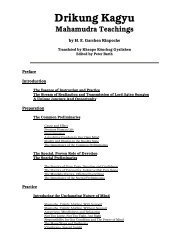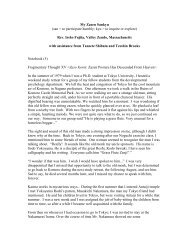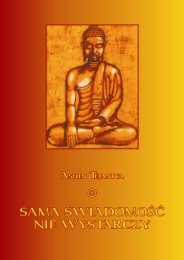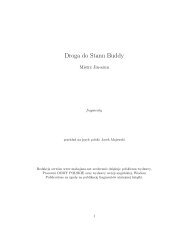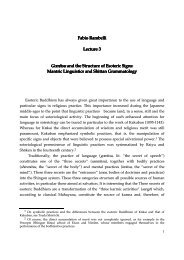- Page 5: TO THE DEAR MEMORYOFMY BELOVED MOTH
- Page 8 and 9: VIPagePart IL —The Sensible World
- Page 10 and 11: VIIIPageg) The Causal and Hypotheti
- Page 12 and 13: ABBREVIATIONSAnekSntaj. Anekanta-ja
- Page 14 and 15: XIIIn addressing itself to the phil
- Page 16 and 17: VaiSesika
- Page 24 and 25: NirvaNa,Svatantrika
- Page 26 and 27: 12 BUDDHIST LOGICby two great men,
- Page 28 and 29: 14 BUDDHIST LOGICgreatest men of th
- Page 30: Nirvana
- Page 36 and 37: MI m a m s a.
- Page 38 and 39: 24 BUDDHIST LOGICand the same entit
- Page 40 and 41: 2 6 BUDDHIST LOGICuniversals and re
- Page 42 and 43: 28 BUJDDHIST LOGIClater than the ot
- Page 44 and 45: 30 BUDDHIST LOGICVada-vidhi means
- Page 46 and 47: 32 BUDDHIST LOGICVII century A. D.,
- Page 48 and 49: 34 BUDDHIST LOGICfixing his residen
- Page 50 and 51: 36 BUDDHIST LOGICI care to write fo
- Page 52 and 53: 38 BUDDHIST LOGIC§11. THE OKDEE OF
- Page 54 and 55: 40 BUDDHIST LOGICof interpretation
- Page 56 and 57: 42 BUDDHIST LOGICAnother subcomment
- Page 58 and 59: 44 BUDDHIST LOGICfor the less gifte
- Page 60 and 61: 46 BUDDHIST LOGICA position quite a
- Page 62 and 63: 48 BUDDHIST LOGICin the pale of Ved
- Page 64 and 65: 50 BUDDHIST LOGICof super-realism 1
- Page 66 and 67: 52 BUDDHIST LOGICof reformed Vedant
- Page 68 and 69: 54 BUDDHIST LOGICNyaya-mukha (= Nya
- Page 70 and 71: 56 BUDDHIST LOGICTibetan work of th
- Page 72 and 73: 58 BUDDHIST LOGICto a critically ag
- Page 74 and 75: 60 BUDDHIST LOGICbut he expects it,
- Page 76 and 77: 62 BUDDHIST LOGICto the origin of k
- Page 78 and 79: 64 BUDDHIST LOGICanalysis, logic ha
- Page 80 and 81: 66 BUDDHIST LOGICbeen given x and h
- Page 82 and 83: 68 BUDDHIST LOGICwith an agent, an
- Page 84 and 85:
70 BUDDHIST LOGICa concrete Univers
- Page 86 and 87:
72 BUDDHIST LOGICof time, place and
- Page 88 and 89:
74 BUDDHIST LOGICindirectly in an i
- Page 90 and 91:
76 BUDDHIST LOGICWe find in Dharmot
- Page 92 and 93:
78 BUDDHIST LOGICand the law of nir
- Page 94 and 95:
80 BUDDHIST LOGIGsplit in discrete
- Page 96 and 97:
82 BUDDHIST LOGICconditions, 1 the
- Page 98 and 99:
84 BUDDHIST LOGIC§ 3. ABGUMENT FRO
- Page 100 and 101:
86 BUDDHIST LOGICof duration and ex
- Page 102 and 103:
88 BUDDHIST LOGIC§ 6. RECOGNITION
- Page 104 and 105:
90 BUDDHIST LOGICExample. 1 As, e.
- Page 106 and 107:
92 BUDDHIST LOGICbegins to move; a
- Page 108 and 109:
94 BUDDHIST LOGICnil, says the Budd
- Page 110 and 111:
96 BUDDHIST LOGICdoes not exist, be
- Page 112 and 113:
98 BUDDHIST LOGICis other». The ca
- Page 114 and 115:
100 BUDDHIST LOGICon the contrary,
- Page 116 and 117:
102 BUDDHIST LOGIC§ 12. ANNIHILATI
- Page 118 and 119:
104 BUDDHIST LOGICof other things,
- Page 120 and 121:
106 BUDDHIST LOGIC§ 14. IS THE POI
- Page 122 and 123:
108 BUDDHIST LOGICthat they applied
- Page 124 and 125:
110 BUDDHIST LOGICNow just in the m
- Page 126 and 127:
112 BUDDHIST LOGICelements represen
- Page 128 and 129:
114 BUDDHIST LOGICwas imagined to r
- Page 130 and 131:
116 BUDDHIST LOGICDependent Origina
- Page 132 and 133:
118 BUDDHIST LOGICmotionless, for i
- Page 134 and 135:
120 BUDDHIST LOGICNot even two mome
- Page 136 and 137:
122 BUDDHIST LOGICthere is a change
- Page 138 and 139:
124 BUDDHIST LOGICempirical cogniti
- Page 140 and 141:
126 BUDDHIST LOGICefficacy, 1 the c
- Page 142 and 143:
128 BUDDHIST LOGICone unity produce
- Page 144 and 145:
* 30 BUDDHIST LOGIC« Every variety
- Page 146 and 147:
132 BUDDHIST LOGICindicated. Accord
- Page 148 and 149:
134 BUDDHIST I
- Page 150 and 151:
136 BUDDHIST LOGICmixed them up, as
- Page 152 and 153:
138 BUDDHIST LOGICarises in mutual
- Page 154 and 155:
140 BUDDHIST LOGICtogether with org
- Page 156 and 157:
142 BUDDHIST LOGICof scholars imagi
- Page 158 and 159:
144 BUDDHIST LOGICexact coincidence
- Page 160 and 161:
146 BUDDHIST LOGICCHAPTER III.SENSE
- Page 162 and 163:
148 BUDDHIST LOGICof knowledge is
- Page 164 and 165:
150 BUDDHIST LOGICand it amounts to
- Page 166 and 167:
152 BUDDHIST LOGICKamalasila refers
- Page 168 and 169:
154 BUDDHIST LOGICeye-disease, owin
- Page 170 and 171:
156 BUDDHIST LOGICintellect, not a
- Page 172 and 173:
158 BUDDHIST LOGICbeing rapidly tur
- Page 174 and 175:
160 BUDDHIST LOG1UIt would lead us
- Page 176 and 177:
162 BUDDHIST LOGICunderstanding was
- Page 178 and 179:
164 BUDDHIST LOGICYogacara school a
- Page 180 and 181:
166 BUDDHIST LOGICEgo itself is cog
- Page 182 and 183:
168 BUDDHIST LOGICwe perceive a pat
- Page 184 and 185:
170 BUDDHIST LOGICmentioned above,
- Page 186 and 187:
172 BUDDHIST LOGICown special spher
- Page 188 and 189:
174 BUDDHIST LOGICDignaga and Dharm
- Page 190 and 191:
1 7 G BUDDHIST LOGICunutterability
- Page 192 and 193:
178 BUDDHIST LOGICknowledge of any
- Page 194 and 195:
ISOBUDDHIST LOGICAccording to Sigwa
- Page 196 and 197:
182 BUDDHIST LOGIC2) every such obj
- Page 198 and 199:
184 BUDDHIST LOGICwill not be parti
- Page 200 and 201:
186 BUDDHIST LOGICIn the first mome
- Page 202 and 203:
188 BUDDHIST LOGICthe senses direct
- Page 204 and 205:
190 P.UDDHIST LOGICreality is just
- Page 206 and 207:
192 BUDDHIST LOGICmolecules and hig
- Page 208 and 209:
194 BUDDHIST LOGICschool of the Mad
- Page 210 and 211:
196 BUDDHIST LOGICobjects and their
- Page 212 and 213:
198 BUDDHIST LOGICindividual object
- Page 214 and 215:
200 BUDDHIST LOGICjust as Aristotle
- Page 216 and 217:
202 BUDDHIST LOGICconstruction. 1 B
- Page 218 and 219:
PARTIII.THE CONSTRUCTED WORLD.CHAPT
- Page 220 and 221:
206 BUDDHIST LOGICfrom «pure sensa
- Page 222 and 223:
208 BUDDHIST LOGICsenses and by the
- Page 224 and 225:
210 BUDDHIST LOGICdirect sensation.
- Page 226 and 227:
212 BUDDHIST LOGICThis judgment of
- Page 228 and 229:
214 BUDDHIST LOGICdifference, to sy
- Page 230 and 231:
21 G BUDDHIST LOGICthe name indicat
- Page 232 and 233:
218 BUDDHIST LOGICno connotation, 1
- Page 234 and 235:
220 BUDDHIST LOGICthought in our co
- Page 236 and 237:
222 BUDDHIST LOGICas non-different
- Page 238 and 239:
224 BUDDHIST LOGICThe roles are oth
- Page 240 and 241:
226 BUDDHIST LOGICof sensuous reali
- Page 242 and 243:
228 BUDDHIST LOGICperceptual one. I
- Page 244 and 245:
230 BUDDHIST LOGICBut from all Euro
- Page 246 and 247:
232 BUDDHIST LOGICits presence will
- Page 248 and 249:
234 BUDDHIST LOGICsubject «mountai
- Page 250 and 251:
236 BUDDHIST LOGIC§ 3. THE VARIOUS
- Page 252 and 253:
238 BUDDHIST LOGICassume that the i
- Page 254 and 255:
240 BUDDHIST LOGICtherefore be free
- Page 256 and 257:
242 BUDDHIST LOGICdivided into two
- Page 258 and 259:
244 BUDDHIST LOGICtaught by the Bud
- Page 260 and 261:
246 BUDDHIST LOGICof the so connect
- Page 262 and 263:
248 BUDDHIST LOGICwho buy goods wit
- Page 264 and 265:
250 BUDDHIST LOGICSmoke and fire ar
- Page 266 and 267:
252 BUDDHIST LOGIC§ 10. THE FINAL
- Page 268 and 269:
254 BUDDHIST LOGICTABLE OF CATEGORJ
- Page 270 and 271:
256 BUDDHIST LOGICit is just the sa
- Page 272 and 273:
258 BUDDHIST LOGICbecause we know f
- Page 274 and 275:
260 BUDDHIST LOGIC§ 13. UNIVERSAL
- Page 276 and 277:
262 BUDDHIST LOGICand Sankhya share
- Page 278 and 279:
264 BUDDHIST LOGICitself (as a sens
- Page 280 and 281:
266 BUDDHIST LOGICthrough the sense
- Page 282 and 283:
268 BUDDHIST LOGIChigh tide in the
- Page 284 and 285:
270 BUDDHIST LOGICbut the definitio
- Page 286 and 287:
272 BUDDHIST LOGICIf something new
- Page 288 and 289:
274 BUDDHIST LOGICThe division of a
- Page 290 and 291:
276 BUDDHIST LOGICand major premise
- Page 292 and 293:
278 BUDDHIST LOGICinstinct and reve
- Page 294 and 295:
280 BUDDHIST LOGICand Dharmaklrti e
- Page 296 and 297:
282 BUDDHIST LOGICfrom the major pr
- Page 298 and 299:
284 BUDDHIST LOGICby implication th
- Page 300 and 301:
286 BUDDHIST LOGICpresence of fire
- Page 302 and 303:
288 BUDDHIST LOGICused it the sense
- Page 304 and 305:
290 BUDDHIST LOGICnot a tree. He wi
- Page 306 and 307:
292 BUDDHIST LOGIC(padartha). It se
- Page 308 and 309:
294 BUDDHIST LOGIC1. If the effect
- Page 310 and 311:
296 BUDDHIST LOGICof a Syllogism, 5
- Page 312 and 313:
298 BUDDHIST LOGICalways included i
- Page 314 and 315:
300 BUDDHIST LOGICSuch a syllogism
- Page 316 and 317:
302 BUDDHIST LOGICthe fact that the
- Page 318 and 319:
304 BUDDHIST LOGICGrammatically the
- Page 320 and 321:
306 BUDDHIST LOGICNow if the field
- Page 322 and 323:
308 BUDDHIST LOGICconsequence to th
- Page 324 and 325:
310 BUDDHIST LOGICif it were not a
- Page 326 and 327:
312 BUDDHIST LOGICa hypothetical ju
- Page 328 and 329:
314 BUDDHIST LOGICarguments. We can
- Page 330 and 331:
316 BUDDHIST LOGICthrough a superst
- Page 332 and 333:
318 BUDDHIST LOGICexpressedly) admi
- Page 334 and 335:
320 BUDDHIST LOGICCHAPTER V.LOGICAL
- Page 336 and 337:
322 BUDDHIST LOGICthe dissimilar on
- Page 338 and 339:
324 BUDDHIST LOGICTogether, 18 item
- Page 340 and 341:
326 BUDDHIST LOGICone. A fallacy is
- Page 342 and 343:
328 BUDDHIST LOGICNot only doubt re
- Page 344 and 345:
330 BUDDHIST LOGICtrees close their
- Page 346 and 347:
332 BUDDHIST LOGICtherefore establi
- Page 348 and 349:
334 BUDDHIST LOGICAt the left upper
- Page 350 and 351:
336 BUDDHIST LOGICthe analogy of at
- Page 352 and 353:
338 BUDDHIST LOGICBut logic evident
- Page 354 and 355:
340 BUDDHIST LOGICAs stated above,
- Page 357 and 358:
LOGICAL FALLACIES 343the presence o
- Page 359 and 360:
LOGICAL FALLACIES 345maintained tha
- Page 361 and 362:
LOGICAL FALLACIES 347to the Buddhis
- Page 363 and 364:
LOGICAL FALLACIES 349Thus Prasastap
- Page 365 and 366:
LOGICAL FALLACIES 351contrary, 1 th
- Page 367 and 368:
LOGICAL FALLACIES 353The following
- Page 369 and 370:
LOGICAL FALLACIES 355«A fallacy is
- Page 371 and 372:
LOGICAL FALLACIES 357of profit, of
- Page 373 and 374:
LOGICAL FALLACIES 359day-time,ergo
- Page 375 and 376:
LOGICAL FALLACIES 361found in simil
- Page 377 and 378:
PART IV.NEGATION.CHAPTER I.THE NEGA
- Page 379 and 380:
THE NEGATIVE JUDGMENT 365Negation i
- Page 381 and 382:
THE NEGATIVE JUDGMENT 367perception
- Page 383 and 384:
THE NEGATIVE JUDGMENT 369presence.
- Page 385 and 386:
THE NEGATIVE JUDGMENT 371cross, and
- Page 387 and 388:
THE NEGATIVE JUDGMENT 373of percept
- Page 389 and 390:
THE NEGATIVE JUDGMENT 375the former
- Page 391 and 392:
THE NEGATIVE JUDGMENT 377tions, wit
- Page 393 and 394:
THE NEGATIVE JUDGMENT 379dhist theo
- Page 395 and 396:
THE NEGATIVE JUDGMENT ' 381cold is
- Page 397 and 398:
THE NEGATIVE JUDGMENT 383{alternate
- Page 399 and 400:
THE NEGATIVE JUDGMENT 385sensuous 1
- Page 401 and 402:
THE NEGATIVE JUDGMENT 387(of the pr
- Page 403 and 404:
THE NEGATIVE J[JDGMENT 389by the se
- Page 405 and 406:
THE NEGATIVE JUDGMENT 391tion or ju
- Page 407 and 408:
THE NEGATIVE JUDGMENT 393absence of
- Page 409 and 410:
THE NEGATIVE JUDGMENT 395According
- Page 411 and 412:
THE NEGATIVE JUDGMENT 397negative q
- Page 413 and 414:
THE NEGATIVE JUDGMENT 399tion and j
- Page 415 and 416:
THE LAW OF CONTRADICTION 401regard
- Page 417 and 418:
THE LAW OF CONTRADICTION 403cepts a
- Page 419 and 420:
THE LAW OF CONTEADICTION 405they ar
- Page 421 and 422:
THE LAW OF CONTKADICTION 407exclusi
- Page 423 and 424:
THE LAW OF CONTRADICTION 409§ 4. L
- Page 425 and 426:
THE LAW OF CONTBADICTION 411phasis,
- Page 427 and 428:
THE LAW OF CONTBADICTION 413Thus th
- Page 429 and 430:
THE LAW OF CONTRADICTION 415A separ
- Page 431 and 432:
THE LAW OF CONTBAMCTION 417seen, is
- Page 433 and 434:
THE LAW OF CONTBADICTION 419c) The
- Page 435 and 436:
THE LAW OF CONTBADICTION 421the obj
- Page 437 and 438:
THE LAW OF CONTRADICTION 423there w
- Page 439 and 440:
THE LAW OP CONTEADICTION 425the sec
- Page 441 and 442:
THE LAW OF CONTRADICTION 427essenti
- Page 443 and 444:
THE LAW OP CONTBADiCTION 429disclos
- Page 445 and 446:
THE LAW OF CONTEADICTION 431ment wh
- Page 447 and 448:
THE LAW OF CONTRADICTION 433always
- Page 449 and 450:
THE LAW OF CONTEADICTION 435In this
- Page 451 and 452:
THE LAW OF CONTRADICTION 437ftt dif
- Page 453 and 454:
THE LAW OF CONTBADICTION 439indefin
- Page 455 and 456:
THE LAW OF CONTEADICTION 441itself,
- Page 457 and 458:
THE LAW OP CONTBADICTION 443threefo
- Page 459 and 460:
UNIVERSALS 445theory. 1 It is Ideal
- Page 461 and 462:
UNIVEESALS 447in every individual c
- Page 463 and 464:
UNIVEKSALS 449To the first historic
- Page 465 and 466:
UNIVEESAIiS 451the same which in gr
- Page 467 and 468:
UNIVERSALS 453one; for these are bo
- Page 469 and 470:
UN1VEB8AL8 455and cooks. The ideal
- Page 471 and 472:
DIALECTIC 457CHAPTER IV.DIALECTIC.
- Page 473 and 474:
DIALECTIC 459defined as an indirect
- Page 475 and 476:
DIALECTIC 461discrepancy". 1 His cr
- Page 477 and 478:
DIALECTIC 483asserting one's own me
- Page 479 and 480:
DIALECTIC 465(according to one syst
- Page 481 and 482:
DIALECTIC 467is proved (that the Un
- Page 483 and 484:
DIALECTIC 469know that «these alon
- Page 485 and 486:
DIALECTIC 471which we never profess
- Page 487 and 488:
DIALECTIC 473the observer). It is m
- Page 489 and 490:
DIALECTIC 475(319. 23). At first we
- Page 491 and 492:
DIALECTIC 477and names are negative
- Page 493 and 494:
DIALECTIC 479Manifold disappears wi
- Page 495 and 496:
DIALECTIC 481This objection is disp
- Page 497 and 498:
DIALECTIC 483by yes nor by no, and
- Page 499 and 500:
DIALECTIC 485However he takes a fur
- Page 501 and 502:
DIALECTIC 487tivity is the Soul of
- Page 503 and 504:
DIALECTIC 489places». Then the onl
- Page 505 and 506:
DIALECTIC 491everything in the Univ
- Page 507 and 508:
DIALECTIC 493noticing it, he would
- Page 509 and 510:
DIALECTIC 495blue and only for this
- Page 511 and 512:
DIALECTIC 497a union between two qu
- Page 513 and 514:
DIALECTIC 499the other by the admix
- Page 515 and 516:
DIALECTIC 501ment reduces .to the f
- Page 517 and 518:
DIALECTIC 503In accord with this Ul
- Page 519 and 520:
DIALECTIC 505is here called a defin
- Page 521 and 522:
REALITY OF THE EXTERNAL WORLD 507ex
- Page 523 and 524:
REALITY OF THE EXTERNAL WORLD 509og
- Page 525 and 526:
REALITY OF THE EXTERNAL WORLD 511ex
- Page 527 and 528:
BEAUTY OF THE EXTEBNAL WOULD 513are
- Page 529 and 530:
REALITY OF THE EXTERNAL WORLD 515in
- Page 531 and 532:
KEALITY OF THE EXTEBNAL WOULD 517on
- Page 533 and 534:
REALITY OF THE EXTERNAL WORLD 519st
- Page 535 and 536:
REALITY OF THE EXTERNAL WORLD 521re
- Page 537 and 538:
REALITY OF THE EXTERNAL WORLD 523th
- Page 539 and 540:
REALITY OF THE EXTEENAL WORLD 525«
- Page 541 and 542:
REALITY OP THE EXTEKNAL WORLD 527in
- Page 543 and 544:
REALITY OF THE EXTERNAL WORLD 529th
- Page 545 and 546:
REALITY OF THE EXTEENAL WORLD 531kn
- Page 547 and 548:
REALITY OF THE EXTEBNAL WOELD 533co
- Page 549 and 550:
BEAUT* OP THE EXTEBNAL WOBLD 535Suc
- Page 551 and 552:
BEAUTY OF THE EXTEENAL WOBLD 5373-r
- Page 553 and 554:
REALITY OF THE EXTERNAL WORLD 539c)
- Page 555 and 556:
EEALITY OF THE EXTEBNAL WOKLD 541in
- Page 557 and 558:
KEALITY OF THE EXTEENAL WOELD 543di
- Page 559 and 560:
EEALITY OF THE EXTEKNAL WORLD 545Bu
- Page 561 and 562:
Cakrapani,CarvakaJNAnaSrimitra,Ksan
- Page 563 and 564:
VaibhasikaSata-Sastra,SarvajNAta-mu
- Page 565 and 566:
INDEX OF PBOPER NAMES 551U-yug-pa-r
- Page 567 and 568:
INDEX OF MAIN LOGICAL TOPICS 553Con
- Page 569 and 570:
INDEX OF MAIN LOGICAL TOPICS 555rea
- Page 571 and 572:
INDEX OF MAIN LOGICAL TOPICS 557Thi
- Page 573 and 574:
ADDENDA ET CORRIGENDAPage1792728268



![Shushogi, Dogen Zenji [PDF] - Mahajana.net](https://img.yumpu.com/50921105/1/190x219/shushogi-dogen-zenji-pdf-mahajananet.jpg?quality=85)

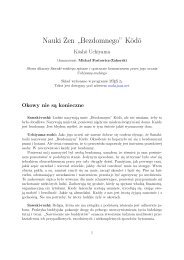

![wywiadu z Murakami Kosho Roshim [PDF] - Buddyzm w Polsce i na ...](https://img.yumpu.com/45809746/1/184x260/wywiadu-z-murakami-kosho-roshim-pdf-buddyzm-w-polsce-i-na-.jpg?quality=85)



